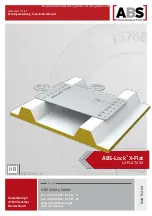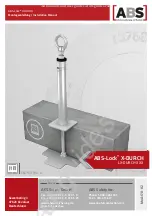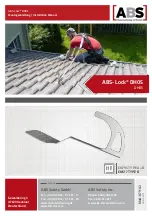
12
6.0 Inspection and
Maintenance
6.1 Inspection and Operation
Testing
Honeywell’s inspection requirements
incorporate the criteria established by current
safety standards. The inspection criteria
for the equipment shall be set by the user’s
organization, such that it equals or exceeds
the criteria required by the manufacturer and
the standards with which the organization
elects to comply.
(TXLSPHQW VKDOO EH WKRURXJKO\ LQVSHFWHG
DQGRSHUDWLRQDOO\WHVWHGE\WKHXVHUEHIRUH
HDFKXVHDQGDGGLWLRQDOO\E\DFRPSHWHQW
SHUVRQ RWKHU WKDQ WKH XVHU DW UHJXODU
LQWHUYDOVRIQRPRUHWKDQRQH\HDUIRU
[*ANSI Z359.14 provides additional inspection
requirements based on type of use and conditions
of use. Refer to Table 3: ANSI Z359.14 Appendix
A: Inspection Requirements for compliance with this
standard. (*See note in 6.2 Maintenance.)]
9
Absence or illegibility of markings/labels.
9
Absence of any elements affecting the
HTXLSPHQWIRUP¿WRUIXQFWLRQ
9
Evidence of defects in or damage to the
cable or webbing lifeline including fraying,
cuts, broken strands, burns, corrosion,
kinks, chemical attack, abrasion, alteration,
excessive aging, excessive wear, and loose,
broken or pulled stitches.
CAUTION:
$OZD\V ZHDU JORYHV ZKHQ
LQVSHFWLQJ FDEOH OLIHOLQHV EURNHQ VWUDQGV
FDQFDXVHLQMXU\
9
Operational damage to the lifeline.
Retraction
- With the device in a mounted po-
sition, test the lifeline retraction and tension by
pulling out several feet of the lifeline and allow
to retract back into the unit. Always maintain a
light tension on the lifeline as it retracts. The
lifeline should pull out freely and retract all the
way back into the unit. If the lifeline does not
pull out smoothly or sticks when retracting,
pull all the lifeline out of the housing and allow
it to retract slowly under tension. Do not use
the unit if the lifeline does not retract properly.
CAUTION:
'RQRWOHWJRRIWKHOLIHOLQHDQG
OHW LW UHWUDFW RQ LWV RZQ DOZD\V PDLQWDLQ
WHQVLRQZKLOHLWUHWUDFWV
/RFNXS 0HFKDQLVP
- The braking mecha-
nism can be tested by grasping the lifeline and
applying a sharp steady pull downward which
will engage the brakes. There should be no
slippage of the lifeline while the brakes are en-
gaged. Once tension is released, the brakes
will disengage and the unit will return to the
retractable mode.
9
Evidence of defects in or damage to
hardware elements including cracks, breaks,
rough or sharp edges, deformation, corrosion,
chemical attack, excessive heating, pitted
surfaces, alteration, and excessive wear.
9
Operational damage to the hardware.
6QDS +RRN&DUDELQHRRN
- The
connector gate (keeper) should seat into the
nose without binding and should not be dis-
torted or obstructed. The gate spring should
H[HUWVXI¿FLHQWIRUFHWR¿UPO\FORVHWKHJDWH
The gate locking mechanism must prevent the
gate from opening when closed.
Swivels
- The connector and anchorage swiv-
els should operate smoothly.
7\SHRI
Use
$SSOLFDWLRQ
([DPSOHV
Conditions of Use
,QVSHFWLRQ
)UHTXHQF\
&RPSHWHQW
Person
Infrequent
to Light
5HVFXH FRQ¿QHG
space, Factory
maintenance
Good storage conditions, indoor or
infrequent outdoor use, room temperature,
clean environments
Annually
Moderate to
Heavy
Transportation,
Residential construction,
Utilities, Warehouse
Fair storage conditions, indoor and
extended outdoor use, all temperatures,
clean or dusty environments
Semi-annually
to annually
Severe to
Continuous
Commercial
construction,
Oil & Gas, Mining
Harsh storage conditions, prolonged or
continuous outdoor use, all temperatures,
dirty environment
Quarterly to
semi-annually
7$%/($16,=$SSHQGL[$,QVSHFWLRQ5HTXLUHPHQWV













































